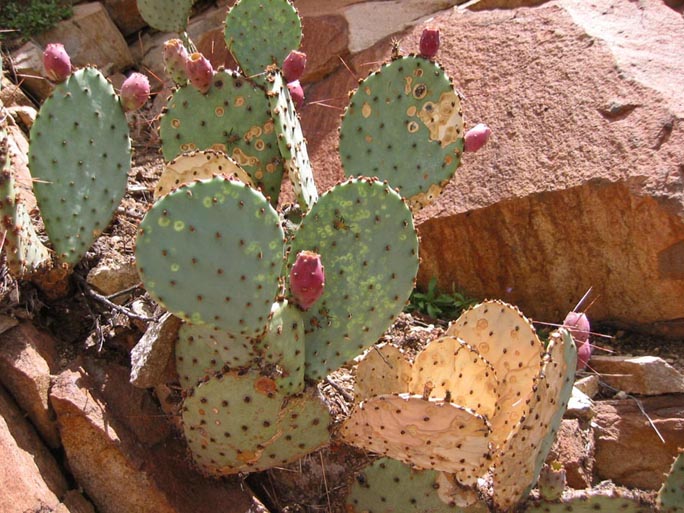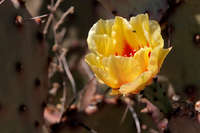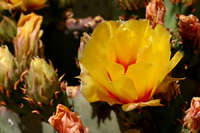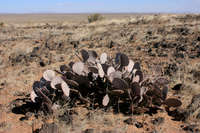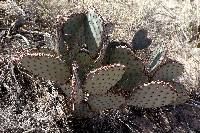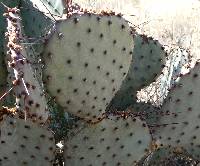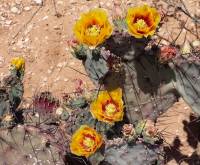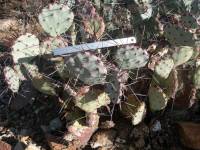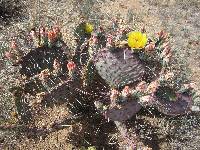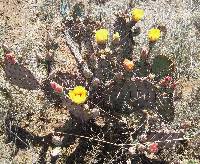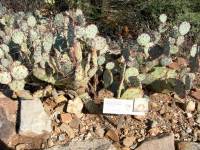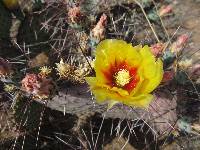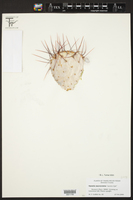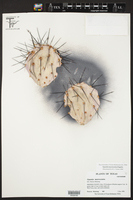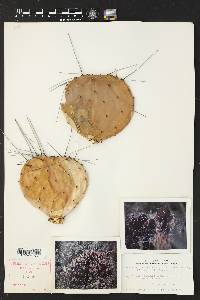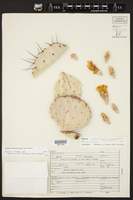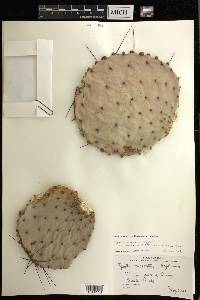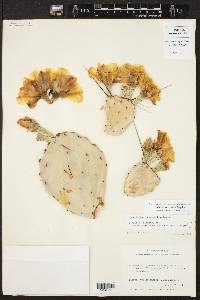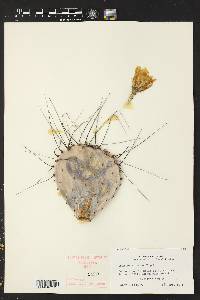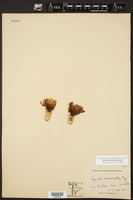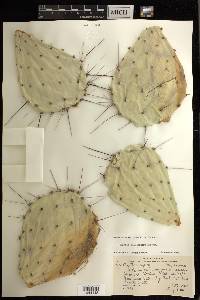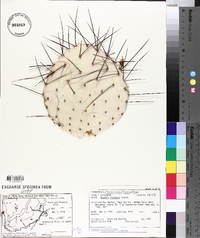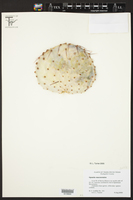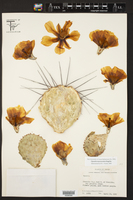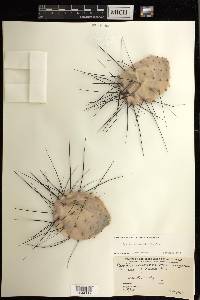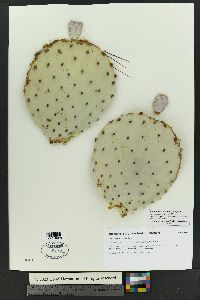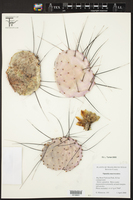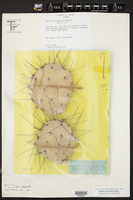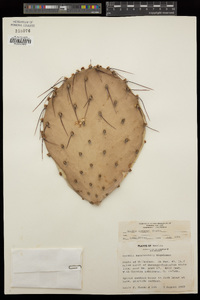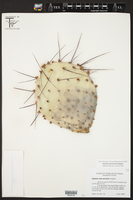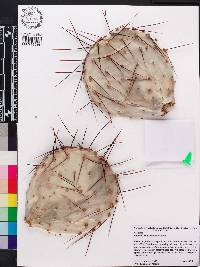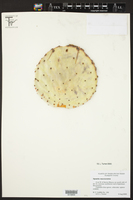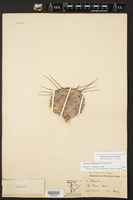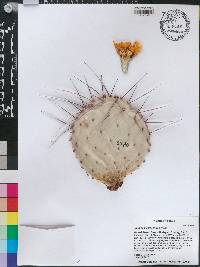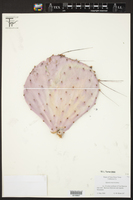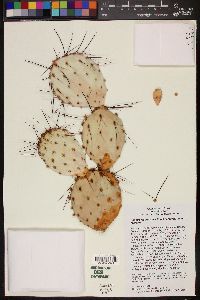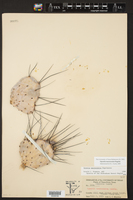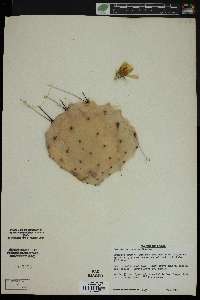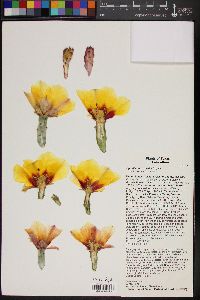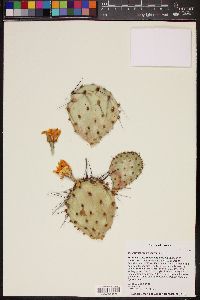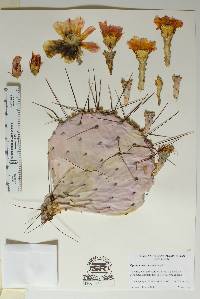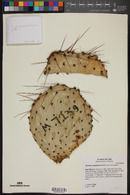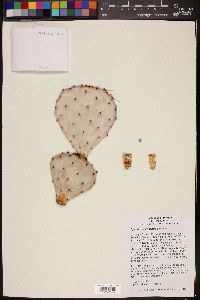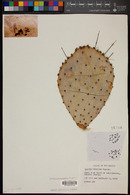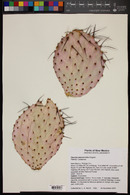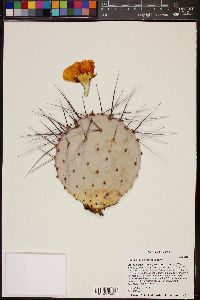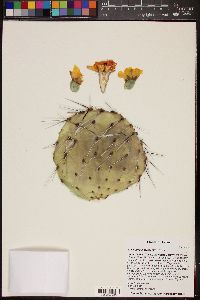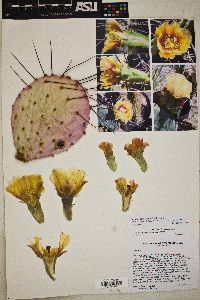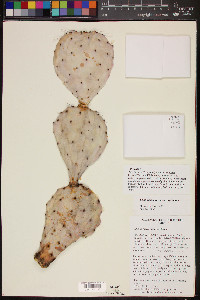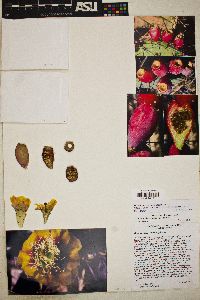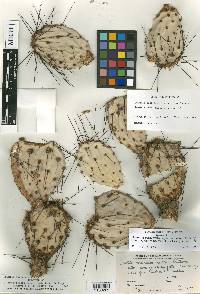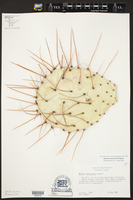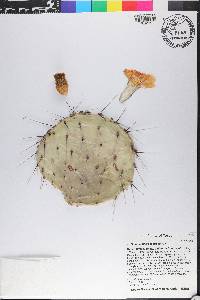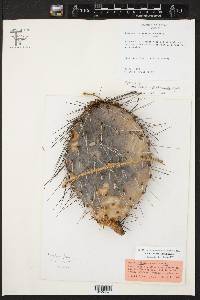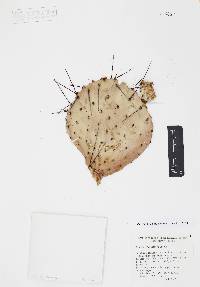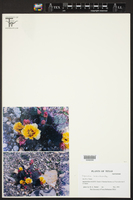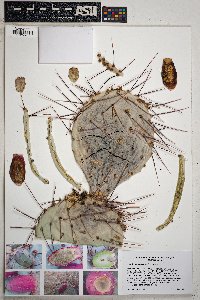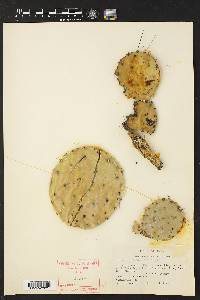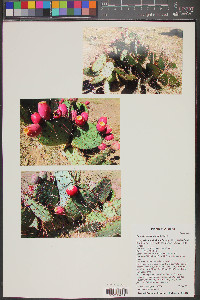Opuntia macrocentra
|
|
|
|
Family: Cactaceae
Long-Spine Purple Prickly-Pear, more...purple pricklypear, long-spined prickly pear, purple prickly pear, purple prickly-pear (es: duraznilla, nopal)
[Opuntia mackensenii var. minor (M. S. Anthony) A. M. Powell & Weedin] |
Shrubs, erect to decumbent, to 1 m. Stem segments not easily detached, purple (particularly under stress) to green with purple near areoles and margins of stem segment, flattened, broadly obovate to subcircular, thickish, 7-20 × 6-18 cm; areoles 6-8(-10) per diagonal row across midstem segment, elliptic to circular, 3-7 × 2.5-5 mm; wool tan to whitish, aging black. Spines 0 or 1-15+ per areole, few and at distal areoles or many and on most areoles, usually erect to spreading, appearing unruly, sometimes deflexed, straight or curving, acicular, often flexible, subterete to flattened basally; longer ones reddish brown to ± black (rarely yellow to red in w Texas), or partly to wholly white, 30-120(-170) mm; reflexed spine rarely present, 1 in some areoles, short, whitish. Glochids dense in crescent at adaxial edge of areole and well-developed subapical tuft, reddish yellow, aging brown, 2-3(-6) mm. Flowers: inner tepals yellow with red basal portions, obovate-apiculate, 25-40 mm; filaments and anthers yellowish; style cream; stigma lobes green. Fruits red to purplish, obovoid to barrel-shaped, 25-40 × 20-23 mm, fleshy or ± juicy, glabrous, spineless; umbilicus 8-10 mm deep; areoles 22-44. Seeds yellowish, suborbicular to reniform, angled, 5-7 × 3.5-5 mm, sides flattened; girdle protruding 0.8-1.2 mm. 2n = 22, 44. Flowering spring (Mar-Jun). Desert uplands, grasslands, oak woodlands, sandy desert flats, rocky hills and valleys; 900-1600 m; Ariz., N.Mex., Tex.; Mexico (Chihuahua, Coahuila, Sonora). Opuntia macrocentra var. minor is represented by relatively short and compact shrubs with a glochid pattern of a dense crescent in the adaxial edge of the areoles like the species and a much taller tuft of spreading glochids. This variety, which grows along the western side of the Rio Grande in Big Bend, Texas, appears best interpreted as a tetraploid hybrid between tetraploid putative parents, Opuntia macrocentra and O. tortispina.
Plant: shrub, erect to decumbent, to 1 m tall. PADS all purple to green with purple near areoles and pad margins, glabrous, broadly obovate to subcircular, thickish, 7-20 cm long, 6-18 cm broad; AREOLES 6-8(-18) in a row diagonal across midpad, elliptic to circular, 3-7 mm long, 2.5-5 mm wide; wool tan to whitish, aging black Leaves: SPINES absent or along distal pad margin to at most areoles, usually erect to spreading, sometimes deflexed, straight or curving, acicular and often flexible, subterete to flattened basally, 0-15+ per areole, the larger ones 5-12(-17) cm long, red-brown to black (rarely yellow to red), partly to wholly chalky white. GLOCHIDS reddish yellow, aging brown, dense in an apical crescent and a well developed subapical tuft, reddish yellow aging brown, 2-3(-6) mm long Flowers: inner tepals yellow with red bases, obovate-apiculate, 2.5-4 cm long; filaments yellowish; style cream; fresh stigmas green Fruit: FRUITS purplish, obovoid to barrel-shaped, spineless, fleshy, sometimes slightly juicy, 2.5-4 cm long, 2-2.3 cm in diameter; umbilicus 8-10 mm deep; areoles 22-44. SEEDS yellowish, suborbicular to reniform, angled, the sides flattened, 5-7 mm long, 3.5-5 mm wide; girdle protruding 0.8-1.2 mm. Misc: Sandy desert flats to rocky hills and valleys, desertic uplands, grasslands or oak woodlands; 900-1600 m (2900-5300 ft); Mar-Jun REFERENCES: Pinkava, Donald J. Cactaceae. 2003. J. Ariz. - Nev. Acad. Sci. Volume 35(2). Benson 1982, FNA 2003, Pinkava 2003, Allred and Ivey 2012 Common Name: purple pricklypear Duration: Perennial Protected Status: Salvage restriced status in Arizona. Spines: Spines emerge from elliptic to circular, tan to whitish areoles which turn black with age; spines usually only present at the areoles near the upper edge of each pad; when present, spines 1-15 or more per areole, with the largest spines 5-12 cm long, erect or spreading but sometimes deflexed, and straight to curving, the color red-brown to black or chalky white; each areole has a crescent-shaped patch of reddish-yellow glochids (fine barbed bristles) which turn brown with age, 2-6 mm long. Flowers: Petals numerous, yellow with red near the base, obovate, 25-40 mm long, with a small pointed tip; stamens numerous, with yellowish filaments; style cream-colored, topped with a ring of green stigma lobes. Fruits: Fruits fleshy and juicy, red to purplish, spineless, obovoid to barrel shaped, 3-4 cm tall by 2 cm wide, with 20-40 areoles bearing minute glochids; seeds flat and round, yellow, 1 mm wide. Ecology: Found on sandy flats to rocky hills and slopes, primarily in Chihuahuan desert and desert grassland, from 3,000-5,500 ft (914-1676 m), flowers March-June. Distribution: s AZ, s NM, s TX; south to n MEX. Notes: This is a common Chihuahuan Desert Opuntia, occurring in southern Arizona to the east of Tucson, through southern New Mexico, to west Texas. It is distinguished by having a growth form that is often somewhat spreading along the ground but still with some erect stems several pads high, up to 1 m tall (the similar O. santa rita is erect and reaches 2 m tall); with purplish pads and dense red-tinted glochids in a crescent at the top of each areole; the spines are sparse but where found, are very long (O. santa rita has fewer and shorter spines); and flowers have yellow petals with red bases (O. santa rita petals are yellow throughout). O. chlorotica has a bluish tinge, while this species has a more distinctive purplish color on the pads, especially in times of stress. O. engelmannii is also similar but usually has a short trunk at the base; lacks the purplish tinge to the pads; and the flowers range from lemon-yellow to red, but are not bicolored like O. macrocentra. O. phaeacantha can have purple-tinged pads but the spines are shorter (3-8 cm long vs. 3-17 cm long in O. macrocentra), and the major spines are flattened, while O. macrocentra has spines that are mostly rounded in cross section, and only flattened at the base. Ethnobotany: The fruit is edible, and the species is cultivated as an ornamental because of its striking purple-tinged pads and bicolored flowers. Etymology: Opuntia is from the Latin root puncti for prickled; macrocentra comes from macro, or large, and the Greek work kentron, or a spur, referring to the long spines. Editor: SBuckley 2010, FSCoburn 2015, AHazelton 2017 |
|
|
|

